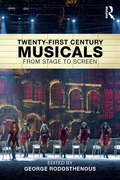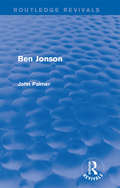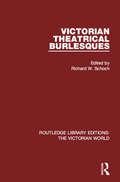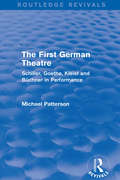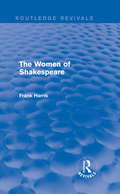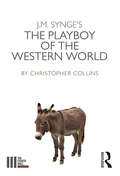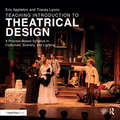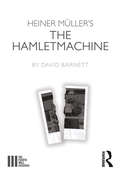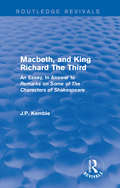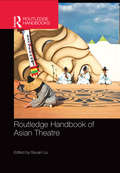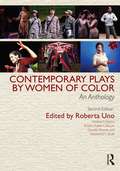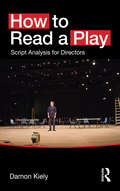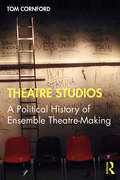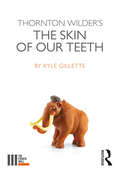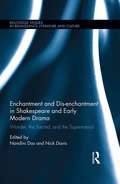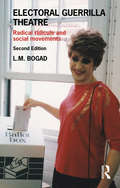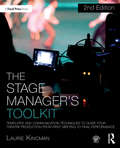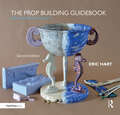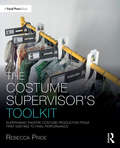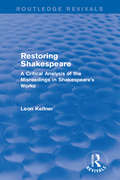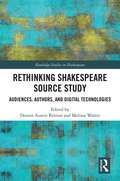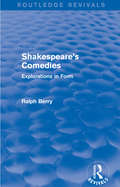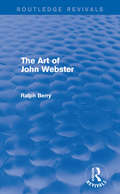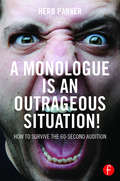- Table View
- List View
Twenty-First Century Musicals: From Stage to Screen
by George RodosthenousTwenty-First Century Musicals stakes a place for the musical in today’s cinematic landscape, taking a look at leading contemporary shows from their stage origins to their big-screen adaptations. Each chapter offers a new perspective on a single musical, challenging populist narratives and exploring underlying narratives and sub-texts in depth. Themes of national identity; race, class and gender; the ‘voice’ and ‘singing live’ on film; authenticity; camp sensibilities; and the celebration of failure are addressed in a series of questions including: How does the film adaptation provide a different viewing experience from the stage version? What themes are highlighted in the film adaptation? What does the new casting bring to the work? Do camera angles dictate a different reading from the stage version? What is lost/gained in the process of adaptation to film? Re-interpreting the contemporary film musical as a compelling art form, Twenty-First Century Musicals is a must-read for any student or scholar keen to broaden their understanding of musical performance.
Ben Jonson (Routledge Revivals)
by John PalmerOriginally published in 1934, Palmer’s biography of famous playwright Ben Jonson delves into his life and works and what he achieved in both. As first poet laureate of England, Jonson’s life presents a fascinating look into the state of literature and theatre in renaissance Britain which Palmer presents in great detail. This title will be of interest to students of literature.
Victorian Theatrical Burlesques (Routledge Library Editions: The Victorian World)
by Richard W. SchochFirst published in 2003. Wildly popular in their own day, Victorian burlesques are now little read, scarcely studied, and never performed. Giving long overdue emphasis to an unjustly neglected theatrical tradition, this critical edition - the first to focus on Victorian burlesques of Victorian plays - represents a valuable scholarly tool for students and scholars of modern drama, theatre history, and nineteenth-century popular culture. Victorian Theatrical Burlesques includes a 'state-of-the-art' introduction which provides a general overview of theatrical burlesques in the Victorian era, emphasising performance history. Sustained reference is made to burlesques other than those presented in the anthology. Through its general introduction, prefaces and annotations to individual plays, checklist of burlesque plays, and bibliography, the unique volume allows both specialist and non-specialist readers to see Victorian burlesques as a rich historical record of shifting attitudes toward drama and the theatre.
The First German Theatre (Routledge Revivals): Schiller, Goethe, Kleist and Büchner in Performance
by Michael PattersonFirst published in 1990. The book surveys of the development of German theatre from a market sideshow into an important element of cultural life and political expression. It examines Schiller as ‘theatre poet’ at Mannheim, Goethe’s work as director of the court theatre at Weimar, and then traces the rapid commercial decline that made it difficult for Kleist and impossible for Büchner to see their plays staged in their own lifetime. Four representative texts are analysed: Schiller’s The Robbers, Goethe’s Iphigenia on Tauris, Kleist’s The Prince of Homburg, and Büchner’s Woyzeck. This title will be of interest to students of theatre and German literature.
The Women of Shakespeare (Routledge Revivals)
by Frank HarrisFrank Harris argues that the way women are presented in Shakespeare’s plays and sonnets are a reflection of the real-life women in his life, namely his wife, mother, mistress and daughter. Originally published in 1911, The Women of Shakespeare also analyses the traditional criticism of the time and places his own views in this context. This title will be of interest to students of English Literature.
The Playboy of the Western World (The Fourth Wall)
by Christopher Collins‘I’m thinking this night wasn’t I a foolish fellow not to kill my father in years gone by.’ – Christy Mahon On the first night of J. M. Synge’s The Playboy of the Western World (1907) the audience began protesting in the theatre; by the third night the protests had spilled onto the streets of Dublin. How did one play provoke this? Christopher Collins addresses The Playboy ’s satirical treatment of illusion and realism in light of Ireland’s struggle for independence, as well as Synge’s struggle for artistic expression. By exploring Synge’s unpublished diaries, drafts and notebooks, he seeks to understand how and why the play came to be. This volume invites the reader behind the scenes of this inflammatory play and its first performances, to understand how and why Synge risked everything in the name of art.
Teaching Introduction to Theatrical Design: A Process Based Syllabus in Costumes, Scenery, and Lighting
by Eric Appleton Tracey LyonsTeaching Introduction to Theatrical Design is a week-by-week guide that helps instructors who are new to teaching design, teaching outside of their fields of expertise, or looking for better ways to integrate and encourage non-designers in the design classroom. This book provides a syllabus to teach foundational theatrical design by illustrating process and application of the principals of design in costumes, sets, lights, and sound.
Heiner Müller's The Hamletmachine (The Fourth Wall)
by David Barnett"I’m good Hamlet gi’me a cause for grief" At first glance, readers of The Hamletmachine (1979) could be forgiven for wondering whether it is actually a play at all: it opens with a montage of texts that are not ascribed to a character, there is no vestige of a plot, and the whole piece lasts a total of ten pages. Yet, Heiner Müller’s play regularly features in theatres’ repertoires and is frequently staged by university theatre departments. In four short chapters, David Barnett unpicks the complexities of The Hamletmachine’s writing and frames its author as an experimental, politically committed writer who confronts the shortcomings of his age. In considering the problems Müller poses for the play’s performance, he also discusses two exemplary productions in order to show how the work can engage very different audiences. This book examines why such a compact, radically open, and yet seemingly obscure play has proved so popular.
Macbeth, and King Richard The Third: An Essay, In Answer to Remarks on Some of The Characters of Shakespeare (Routledge Revivals)
by J.P. KembleJohn Philip Kemble was an ambitious and successful stage actor in London, perhaps most well-known for his turn as Shakespeare’s Macbeth. Kemble passionately disagreed with the posthumous work of Thomas Watley, Remarks on Some of the Characters of Shakespeare (1785), particularly Watley’s representations of some of Shakespeare’s greatest villains, Richard III and Macbeth. This title, first published in 1786 (this reprint of the second edition first published in 1970), presents Kemble’s nuanced criticisms of the characters leaving the impression that the villainies of Macbeth and Richard III are indeed similar. A historically important literary reaction, this title will be of interest to students of English literature and literary criticism.
Routledge Handbook of Asian Theatre
by Siyuan LiuRoutledge Handbook of Asian Theatre is an advanced level reference guide which surveys the rich and diverse traditions of classical and contemporary performing arts in Asia, showcasing significant scholarship in recent years. An international team of over 50 contributors provide authoritative overviews on a variety of topics across Asia, including dance, music, puppetry, make-up and costume, architecture, colonialism, modernity, gender, musicals, and intercultural Shakespeare. This volume is divided into four sections covering: Representative Theatrical Traditions in Asia. Cross-Regional Aspects of Classical and Folk Theatres. Modern and Contemporary Theatres in Asian Countries. Modernity, Gender Performance, Intercultural and Musical Theatre in Asia. Offering a cutting edge overview of Asian theatre and performance, the Handbook is an invaluable resource for academics, researchers and students studying this ever-evolving field.
Contemporary Plays by Women of Color: An Anthology
by Roberta UnoIn the two decades since the first edition of Contemporary Plays by Women of Color was published, its significance to the theatrical landscape in the United States has grown exponentially. Work by female writers and writers of color is more widely produced, published, and studied than ever before. Drawing from an exciting range of theaters, large and small, from across the country, Roberta Uno brings together an up-to-date selection of plays from renowned and emerging playwrights tackling a variety of topics. From the playful to the painful, this revised and updated edition presents a rich array of voices, aesthetics, and stories for a transforming America.
How to Read a Play: Script Analysis for Directors
by Damon KielyThe work done on a play before the first rehearsal, the first group reading or even the before the cast have met, can be crucial to the success of a production. Directors and dramaturgs must know how to analyze, understand and interpret a play or performance text if they hope to bring it to life on the stage. This book provides a broad range of tools and methods that can be used when reading a text, including: Lessons from the past. What can we learn from Aristotle, Stanislavsky, Meyerhold, Vakhtangov, Brecht and Harold Clurman? This section establishes the models and methods that underpin much of a director’s work today. A survey of current practices in Western theatre. A combination of research, interviews and observation of practical work addresses the main stages in understanding a play, such as getting to know characters, sharing ideas, mapping the action and grappling with language. A workbook, setting out twenty one ways of breaking down a play, from the general to the particular. Contributions, reflections and interjections from a host of successful directors make this the ideal starting point for anyone who wants to direct a play, or even devise one of their own. This wide range of different approaches, options and techniques allows each reader to create their own brand of play analysis.
Theatre Studios: A Political History of Ensemble Theatre-Making
by Tom CornfordTheatre Studios explores the history of the studio model in England, first established by Konstantin Stanislavsky, Jacques Copeau and others in the early twentieth century, and later developed in the UK primarily by Michel Saint-Denis, George Devine, Michael Chekhov and Joan Littlewood, whose studios are the focus of this study. Cornford offers in-depth accounts of the radical, collective work of these leading theatre companies of the mid-twentieth century, considering the models of ensemble theatre-making that they developed and their remnants in the newly publicly-funded UK theatre establishment of the 1960s. In the process, this book develops an approach to understanding the politics of artistic practices rooted in the work of John Dewey, Antonio Gramsci and the standpoint feminists. It concludes by considering the legacy of the studio movement for twenty-first-century theatre, partly by tracking its echoes in the work of Secret Theatre at the Lyric, Hammersmith (2013–2015). Students and makers of theatre alike will find in this book a provocative and illuminating analysis of the politics of performance-making and a history of the theatre as a site for developing counterhegemonic, radically democratic, anti-individualist forms of cultural production.
Thornton Wilder's The Skin of our Teeth (The Fourth Wall)
by Kyle Gillette"Ladies and gentlemen, I’m not going to play this particular scene tonight." - Sabina Thornton Wilder’s The Skin of Our Teeth (1942) telescopes an audacious stretch of western history and mythology into a family drama, showing how the course of human events operates like theatre itself: constantly mutable, vanishing and beginning again. Kyle Gillette explores Wilder’s extraordinary play in three parts. Part I unpacks the play’s singular yet deeply interconnected place in theatre history, comparing its metatheatrics to those of Stein, Pirandello and Brecht, and finding its anticipation of American fantasias in the works of Vogel and Kushner. Part II turns to the play’s many historic and mythic sources, and examines its concentration of western progress and power into the model of a white, American upper-middle-class nuclear family. Part III takes a longer view, tangling with the play’s philosophical stakes. Gillette magnifies the play’s ideas and connections, teasing out historical, theoretical and philosophical questions on behalf of readers, scholars and audience members alike.
Enchantment and Dis-enchantment in Shakespeare and Early Modern Drama: Wonder, the Sacred, and the Supernatural (Routledge Studies in Renaissance Literature and Culture)
by Nandini Das Nick DavisThis volume addresses dealings with the wondrous, magical, holy, sacred, sainted, numinous, uncanny, auratic, and sacral in the plays of Shakespeare and contemporaries, produced in an era often associated with the irresistible rise of a thinned-out secular rationalism. By starting from the literary text and looking outwards to social, cultural, and historical aspects, it comes to grips with the instabilities of ‘enchanted’ and ‘disenchanted’ practices of thinking and knowledge-making in the early modern period. If what marvelously stands apart from conceptions of the world’s ordinary functioning might be said to be ‘enchanted’, is the enchantedness weakened, empowered, or modally altered by its translation to theatre? We have a received historical narrative of disenchantment as a large-scale early modern cultural process, inexorable in character, consisting of the substitution of a rationally understood and controllable world for one containing substantial areas of mystery. Early modern cultural change, however, involves transpositions, recreations, or fresh inventions of the enchanted, and not only its replacement in diminished or denatured form. This collection is centrally concerned with what happens in theatre, as a medium which can give power to experiences of wonder as well as circumscribe and curtail them, addressing plays written for the popular stage that contribute to and reflect significant contemporary reorientations of vision, awareness, and cognitive practice. The volume uses the idea of dis-enchantment/re-enchantment as a central hub to bring multiple perspectives to bear on early modern conceptualizations and theatricalizations of wonder, the sacred, and the supernatural from different vantage points, marking a significant contribution to studies of magic, witchcraft, enchantment, and natural philosophy in Shakespeare and early modern drama.
Electoral Guerrilla Theatre: Radical Ridicule and Social Movements
by L.M. BogadPraise for the First Edition: 'A major contribution to performance studies. If cynicism and political quietism have quelled your impulse to rage against this sorry state of affairs, Bogad demonstrates, with wit and verve, that it is possible to expose the sham and, through a variety of performative tactics, make a meaningful contribution to democracy.' Modern Drama 'A compelling and urgent read. Bogad’s passion for the topic reminds the reader of the exhilaration of live performance and the importance of engagement in democratic life.' Theatre Journal 'Delightfully written and wonderfully provocative ... Valuable reading for any scholar of social movements.' Mobilization 'As a guide to both theory and action, it is insightful, entertaining and indispensable.' Andrew Boyd, Wrangler-in-Chief, Beautiful Trouble 'Beautifully contextualized within social movement theory, this book enlivens the debate about performative interventions into power.'Jan Cohen-Cruz, Editor, Public, A Journal of Imagining America 'Electoral Guerrilla Theatre deals a refreshing wild card in the repertoire of resistance.' Baz Kershaw, Emeritus Professor, University of Warwick, and author of The Radical In Performance. In liberal democracies across the globe, where the right to vote is framed as both civil right and civic duty, disillusioned creative activists run for public office on satiric, ironic and iconoclastic platforms. With little intention of "winning" in the conventional sense, they use drag, camp and stand-up comedy to undermine the legitimacy of their opponents and sometimes the electoral system itself. This revised and updated edition of Electoral Guerrilla Theatre explores the phenomenon of the satirical election campaign, and questions the purpose of such public political performances. Drawing on extensive archival and ethnographic research, this is an entertaining and illuminating read that will be invaluable to students and scholars working across a variety of disciplines, including performance studies, the social sciences, cultural studies and politics. New case studies for this edition include: Reverend Billy’s run for Mayor of New York City in 2009; Stephen Colbert’s run for President in 2012; Candidates including Superbarrio, the Best Party, Antanas Mockus, and Einstein the Dog.
The Stage Manager's Toolkit: Templates and Communication Techniques to Guide Your Theatre Production from First Meeting to Final Performance (The Focal Press Toolkit Series)
by Laurie KincmanThe Stage Manager’s Toolkit provides a comprehensive account of the role of the stage manager for live theatre with a focus on both written and verbal communication best practices. The book outlines the duties of the stage manager and assistant stage manager throughout a production, discussing not only what to do but why. The book identifies communication objectives for each phase of production, paperwork to be created, and the necessary questions to be answered in order to ensure success.
The Prop Building Guidebook: For Theatre, Film, and TV
by Eric HartExperienced prop maker Eric Hart walks readers through techniques used in historical and contemporary prop making and demonstrates how to apply them to a variety of materials. Hundreds of full-color photographs illustrate the tools and techniques used by professional prop makers throughout the entertainment industry. New features to the second edition include: Updated information on the latest tools and materials used in prop making Both metric and standard measuring units Step-by-step photos on common techniques such as upholstery, mold making, and faux finishing Expanded coverage of thermoplastics, foam, and water-based coatings
The Costume Supervisor’s Toolkit: Supervising Theatre Costume Production from First Meeting to Final Performance (The Focal Press Toolkit Series)
by Rebecca PrideThe Costume Supervisor’s Toolkit explores the responsibilities of a Costume Supervisor within a theatrical, opera or dance production company. Rebecca Pride provides an insight into all manner of processes, beginning with a definition of the role, and offers explanations of the timeline from the first design meetings, leading all the way up to managing fittings and final rehearsals. This how-to guide outlines best working practices, including building a team and creating a Costume Bible, whilst also providing helpful resources such as sizing guides, a list of useful addresses, and case studies from renowned theatrical organizations.
Restoring Shakespeare: A Critical Analysis of the Misreadings in Shakespeare's Works (Routledge Revivals)
by Leon KellnerThe genius of Shakespeare is not always accessible or easily understandable to readers and audiences. Leon Kellner points out that sometimes Shakespeare’s languages does not make sense at all but this is not necessarily because his metaphors are too complex. Rather, the printing of his works is often filled with errors. Originally published in 1925, Kellner’s work explores the reasons and potential mistakes which may account for the unintelligible passages in Shakespeare such as handwriting, abbreviations, and the confusing of pronouns. This title will be of interest to students of English Literature and Linguistics.
Stage Management
by Lawrence Stern Jill GoldStage Management offers readers a practical manual on how to stage manage in all theatre environments. Revered as the authoritative resource for stage management, this text is rich with practical resources, including checklists, diagrams, examples, forms and step-by-step directions. In addition to sharing his own expertise, Stern has gathered practical advice from working stage managers of Broadway, off-Broadway, touring companies, regional, community, and 99-seat Equity waiver theaters. In its 11th edition, the book is now fully in color and updated to include new information on Equity contracts, social media applications in stage management, and working with high school productions.
Rethinking Shakespeare Source Study: Audiences, Authors, and Digital Technologies (Routledge Studies in Shakespeare)
by Dennis Austin Britton Melissa WalterThis book asks new questions about how and why Shakespeare engages with source material, and about what should be counted as sources in Shakespeare studies. The essays demonstrate that source study remains an indispensable mode of inquiry for understanding Shakespeare, his authorship and audiences, and early modern gender, racial, and class relations, as well as for considering how new technologies have and will continue to redefine our understanding of the materials Shakespeare used to compose his plays. Although source study has been used in the past to construct a conservative view of Shakespeare and his genius, the volume argues that a rethought Shakespearean source study provides opportunities to examine models and practices of cultural exchange and memory, and to value specific cultures and difference. Informed by contemporary approaches to literature and culture, the essays revise conceptions of sources and intertextuality to include terms like "haunting," "sustainability," "microscopic sources," "contamination," "fragmentary circulation" and "cultural conservation." They maintain an awareness of the heterogeneity of cultures along lines of class, religious affiliation, and race, seeking to enhance the opportunity to register diverse ideas and frameworks imported from foreign material and distant sources. The volume not only examines print culture, but also material culture, theatrical paradigms, generic assumptions, and oral narratives. It considers how digital technologies alter how we find sources and see connections among texts. This book asserts that how critics assess and acknowledge Shakespeare’s sources remains interpretively and politically significant; source study and its legacy continues to shape the image of Shakespeare and his authorship. The collection will be valuable to those interested in the relationships between Shakespeare’s work and other texts, those seeking to understand how the legacy of source study has shaped Shakespeare as a cultural phenomenon, and those studying source study, early modern authorship, implications of digital tools in early modern studies, and early modern literary culture.
Shakespeare's Comedies: Explorations in Form (Routledge Revivals)
by Ralph BerryIn this lucid and original study, first published in 1972, Ralph Berry discusses the ten comedies that run from The Comedy of Errors to Twelfth Night. Berry’s purpose is to identify the form of each play by relating the governing idea of the play to the action that expresses it. To this end the author employs a variety of standpoints and techniques, and taken together, these chapters present a lively and coherent view of Shakespeare’s techniques, concerns, and development. This title will be of interests to students of literature and drama.
The Art of John Webster (Routledge Revivals)
by Ralph BerryThe Art of John Webster, first published in 1972, is a study of the three extant plays of Webster known to be solely his work. These plays are seen as attempts to achieve in literature the effects of the baroque, a term which related Webster to the larger developments of European art. Their content is analysed in terms of a consistent opposition between evil and the law. The book seeks to re-establish a base for the claims that must be made for Webster as a serious artist. This title will be of interest to students of literature and drama.
A Monologue is an Outrageous Situation!: How to Survive the 60-Second Audition
by Herb ParkerA Monologue is an Outrageous Situation! How to Survive the 60-Second Audition explains how to successfully tackle the "cattle call" acting audition with a sixty-second monologue. Through Q&As, tips, director’s notes, and a glossary full of outrageous actions meant to inspire the actor into truly connecting with the piece, this book shows actors where and how to find a monologue, edit it, and give the best audition possible.
